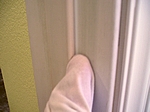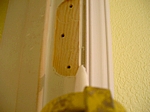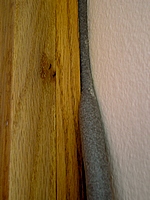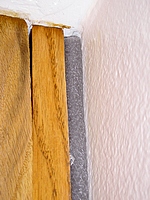Anyplace there is a gap between trim or a cabinet and the wall is a place you should caulk. You will find that most gaps are quite small, so you only need to apply a thin bead of caulk as described in Interior Caulking.
Caulking Stained Trim
Use caulk that complements the color of the wood. For example, if the wall is white, white caulk is the logical choice. If the stain is dark, brown caulk may be a better choice. Apply a thin bead. Use a damp rag to remove any excessive caulk and give it a smooth appearance. A paintable clear caulking can also be used after the walls are painted to seal this gap.
In our illustrations, the previous painters were very sloppy while cutting in with a brush and left very thick and heavy edges on the trim. Neat caulking helped to hide their careless work.
Caulking Painted Trim
Baseboards, door casings and windows need to be checked for gaps. Pay special attention to gaps where the trim meets a frame, door or window. Remove any obstructions, such as hinges or locking mechanisms, for a cleaner look.



Caulking Cracks in Walls
Small cracks in the wallboard can be filled with caulk. The corners of a room is a common area where caulk makes repair quick and easy. Just remember that caulking is only good for small non-structural cracks. Large cracks will need the proper repair.
Caulking 1/4-inch Gaps between Trim and Walls
It is quite common to see larger gaps between a section of cabinet and the wall. You won’t be able to fill a gap that is larger than 1/4-inch with one run of the caulking gun. Usually you will find the only way to fill a gap that is between 1/4-inch to just under 1/2-inch is by applying the caulk to the gap twice. The reason for this is that caulking shrinks as it cures.
Caulking 1/2-inch or Larger Gaps
Very wide gaps, 1/2 inch or wider, must be handled differently. You need to pre-fill very wide gaps prior to applying any sealant. Use foam backer rod, which is available in various widths from 1/2 to over an inch.
Simply push the appropriate thickness of backer rod into the gap. You want to choose a thickness that is slightly larger than the gap. Keep the backer rod just under the surface so the caulk won’t be too thick. You don’t want the caulk to be murch more than a 1/4 inch thick. Wait for the first application of caulking to dry before applying any more.


Additional Caulking Tips
Work with small sections at a time. Filling gaps will go quickly and after a short time you will be caulking like a pro.


